A brief introduction of regular script (楷書)
In 211 BC, Zheng, King of Qin(秦王政), subjugated six remaining major states of Zhou and established the Qin dynasty.
To unify the state and promote commerce, the Qin introduced a range of reforms: standardized currency, weights, measures and a uniform writing system.
The written language of the Qin was logographic, as that of the Zhou had been. Prime minister Li Si (李斯) standardized the writing system to be of uniform size and shape across the whole country. He is credited with creating the "small seal script" (小篆).
During the same period or even earlier, the clerical script (隸書) was developed from the local script varieties in the state of Qin in the Warring States period (戰國時期). For example, Shuihudi Qin bamboo slips (217 BC) (睡虎地秦簡), are seen as a form of early clerical script.
Variant graphs arise during the historical processes of liding (隸定, lit. 'clerical fixing') and libian (隸變, lit. 'clerical changing'). Libian was the natural evolving process of the seal script into the clerical script, which often involved significant omissions, additions, or transmutations of graphical form, while liding is the direct regularization and linearization of shapes to convert them into clerical forms while also preserving the original structure.
The early development of regular script (楷書) started from the Han dynasty. Examples include the Calligraphy Manual of Xuanhe Era (宣和書譜) credit Wang Cizhong (王次仲) with creating regular script based on clerical script in the early Western Han; Xuanshi Biao (宣示表), Jianjizhi Biao (薦季直表), and Liming Biao (力命表), written by Zhong Yao (鍾繇) who lived in the Eastern Han to the Cao Wei period. But regular script did not become dominant until the early Southern and Northern Dynasties (南北朝), in the 5th century.
There was a variety of regular script which emerged from neo-clerical as well as from Zhong Yao's regular script, known as "Wei regular" (魏楷, Weikai) or "Wei stele" (魏碑, Weibei).
Since then, regular script is taken as the official script in Imperial China for more than 15 centuries. During these period, Chinese literary culture were adopted by neighboring countries and states now called 'Chinese-character culture sphere' (漢字文化圈). New derivatives, variations were developing among the culture sphere.
What should be included in the cjkv database
Variant Chinese characters exist within and across all regions where Chinese characters are used, China, Taiwan, Japan, Korea, Vietnam, Singapore etc. Some of the governments of these regions have made efforts to standardize the use of variants, by establishing certain variants as standard.
Start from the Qing dynasty, after the Kangxi Dictionary (康熙字典) was published in 1716, the forms found in the Kangxi dictionary are usually the ones consider to be orthodox(正字), at least by late Imperial China standards. Variants that differ from the orthodox form, mainly used in informal situations, are known as folk variants (俗字). Some of these are longstanding abbreviations or alternate forms.
The first step of the Smaji CJKV project is to collect and record regular script characters. It's a culture-neutral and technology-neutral project. It is not compliance with any so-called standards. It doesn't distinguish which one is orthodox and which one is not.
The only rule to determine whether or not a character glyph should be included is whether it's distinguishable from any already included glyphs in any of the following forms:
- Component. For example, 泪 and 淚.
- Structure. For example, 群 and 羣. Their components are the same but differ in structure (⿰君羊) and (⿱君羊).
- Stroke. For example, 吴 and 吳.
In some instances, the difference between strokes is very subtle. In order to clarify this situation, the following tables list basic and inherited strokes.
Abbreviation form of the basic strokes (10 items)
| Abbr form | Shape of stroke | English name | Chinese name |
|---|---|---|---|
| H | 
|
Horizontal | 橫 |
| V | 
|
Vertical | 豎 |
| T | 
|
Throw | 撇 |
| P | 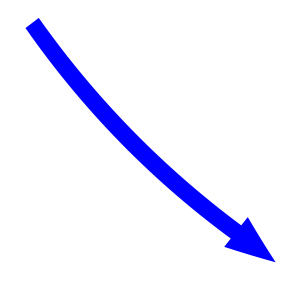
|
Press | 捺 |
| D | 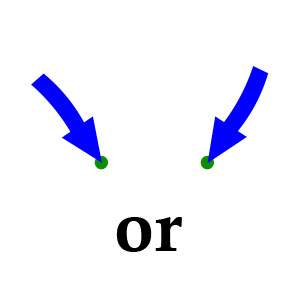
|
Dot | 點 |
| U | 
|
Upward horizontal | 挑 |
| C | 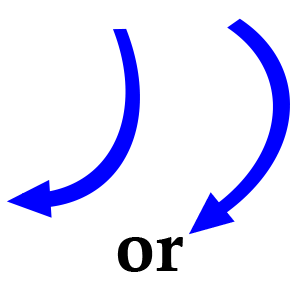
|
Clockwise curve | 彎 |
| A | 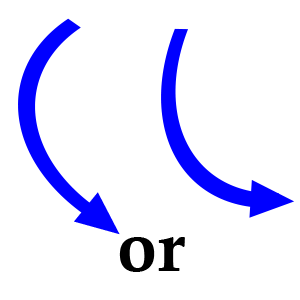
|
Anticlockwise curve | 曲 |
| J | 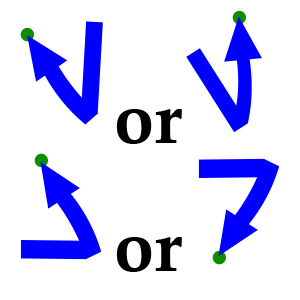
|
J hook | 鈎 |
| O | 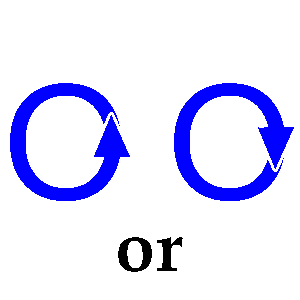
|
Oval | 圈 |
Inherited names of CJK basic and compound strokes (63 items)
| Stroke | Chinese name | Abbr form | Full name | Name in Unicode | Example |
|---|---|---|---|---|---|
| 橫 | H | Horizontal | H | 三 言 隹 花 | |
| 斜橫 | SH | Slanted Horizontal | (H) | 七 弋 宅 戈 | |
| 挑 | U | Upward horizontal | T | 刁 求 虫 地 | |
| 點挑 | DU | Dot – Upward horizontal | (T) | 冰 冷 汗 汁 | |
| 豎 | V | Vertical | S | 十 圭 川 仆 | |
| 斜豎 | SV | Slanted Vertical | (S) | 丑 五 亙 貫 | |
| 右斜豎 | RSV | Right Slanted Vertical | (S) | 𠙴 | |
| 撇 | T | Throw | P | 竹 大 乂 勿 | |
| 扁撇 | FT | Flat Throw | (P) | 千 乏 禾 斤 | |
| 直撇 | WT | Wilted Throw | SP | 九 厄 月 几 | |
| 點 | D | Dot | D | 主 卜 夕 凡 | |
| 長點 | ED | Extended Dot | (D) | 囪 囟 这 凶 | |
| 左點 | LD | Left Dot | (D) | 心 忙 恭 烹 | |
| 直點 | WD | Wilted Dot | (D) | 六 文 宇 空 | |
| 捺 | P | Press | N | 人 木 尺 冬 | |
| 挑捺 | UP | Upward horizontal – Press | TN | 文 廴 父 爻 | |
| 橫捺 | HP | Horizontal – Press | (TN) | 入 八 內 全 | |
| 扁捺 | FP | Flat Press | (N) | 走 足 廴 麵 | |
| 挑扁捺 | UFP | Upward horizontal – Flat Press | (TN) | 之 乏 巡 迴 | |
| 彎 | C | Clockwise curve | W | ||
| 曲 | A | Anticlockwise curve | X | ||
| 圈 | O | Oval | Q | 〇 㔔 㪳 㫈 | |
| 橫鈎 | HJ | Horizontal – J hook | HG | 冧 欠 冝 蛋 | |
| 挑鈎 | UJ | Upward horizontal – J hook | (HG) | 也 乜 池 馳 | |
| 橫撇 | HT | Horizontal – Throw | HP | 夕 水 登 令 | |
| 橫斜 | HSV | Horizontal – Slanted Vertical | (HP) | 今 彔 互 恆 | |
| 橫豎 | HV | Horizontal – Vertical | HZ | 口 己 臼 典 | |
| 橫豎鈎 | HVJ | Horizontal – Vertical – J hook | HZG | 而 永 印 令 | |
| 橫撇鈎 | HTJ | Horizontal – Throw – J hook | (HZG) | 勺 方 力 母 | |
| 挑撇鈎 | UTJ | Upward horizontal – Throw – J hook | (HZG) | 也 乜 池 馳 | |
| 橫豎橫 | HVH | Horizontal – Vertical – Horizontal | HZZ | 凹 兕 卍 雋 | |
| 橫豎挑 | HVU | Horizontal – Vertical – Upward horizontal | HZT | 殼 鸠 说 计 | |
| 橫曲 | HA | Horizontal – Anticlockwise curve | HZW | 朵 沿 殳 没 | |
| 橫曲鈎 | HAJ | Horizontal – Anticlockwise curve – J hook | HZWG | 九 几 凡 亢 | |
| 橫捺鈎 | HPJ | Horizontal – Press – J hook | (HZWG) | 風 迅 飛 凰 | |
| 橫撇曲鈎 | HTAJ | Horizontal – Throw – Anticlockwise curve – J hook | HXWG | 乙 氹 乞 乭 | |
| 橫撇彎 | HTC | Horizontal – Throw – Clockwise curve | --- | 過 过 這 这 | |
| 橫撇橫撇 | HTHT | Horizontal – Throw – Horizontal – Throw | HZZP | 延 建 巡 及 | |
| 橫撇彎鈎 | HTCJ | Horizontal – Throw – Clockwise curve – J hook | HPWG | 陳 陌 那 耶 | |
| 橫豎橫豎 | HVHV | Horizontal – Vertical – Horizontal – Vertical | HZZZ | 凸 𡸭 𠱂 𢫋 | |
| 橫撇橫撇鈎 | HTHTJ | Horizontal – Throw – Horizontal – Throw – J hook | HZZZG | 乃 孕 仍 盈 | |
| 豎挑 | VU | Vertical – Upward horizontal | ST | 卬 氏 衣 比 | |
| 豎橫 | VH | Vertical – Horizontal | SZ | 山 世 匡 直 | |
| 豎曲 | VA | Vertical – Anticlockwise curve | SW | 區 亡 四 匹 | |
| 豎曲鈎 | VAJ | Vertical – Anticlockwise curve – J hook | SWG | 孔 已 亂 也 | |
| 豎橫豎 | VHV | Vertical – Horizontal – Vertical | SZZ | 鼎 亞 吳 卐 | |
| 豎橫撇 | VHT | Vertical – Horizontal – Throw | (SZZ) | 奊 捑 𠱐 𧦮 | |
| 豎橫撇鈎 | VHTJ | Vertical – Horizontal – Throw – J hook | SZWG | 弓 弟 丐 弱 | |
| 豎鈎 | VJ | Vertical – J hook | SG | 小 水 到 寸 | |
| 豎彎 | VC | Vertical – Clockwise curve | SWZ | 肅 嘯 蕭 瀟 | |
| 豎彎鈎 | VCJ | Vertical – Clockwise curve – J hook | --- | 𨙨 𨛜 𨞠 𨞰 | |
| 撇挑 | TU | Throw – Upward horizontal | PZ | 去 公 玄 鄉 | |
| 撇橫 | TH | Throw – Horizontal | (SZ) | 互 母 牙 车 | |
| 撇點 | TD | Throw – Dot | PD | 巡 兪 巢 粼 | |
| 直撇點 | WTD | Wilted Throw – Dot | (PD) | 女 如 姦 㜢 | |
| 撇橫撇 | THT | Throw – Horizontal – Throw | (SZZ) | 夨 𠨮 专 砖 | |
| 撇橫撇鈎 | THTJ | Throw – Horizontal – Throw – J hook | (SZWG) | 巧 亟 污 號 | |
| 撇鈎 | TJ | Throw – J hook | PG | 乄 | |
| 彎鈎 | CJ | Clockwise curve – J hook | WG | 狗 豸 豕 象 | |
| 扁捺鈎 | FPJ | Flat Press – J hook | BXG | 心 必 沁 厯 | |
| 捺鈎 | PJ | Press – J hook | XG | 弋 戈 我 銭 | |
| 撇橫撇曲鈎 | THTAJ | Throw – Horizontal – Throw – Anticlockwise curve – J hook | --- | 𠃉 𦲳 𦴱 鳦 | |
| 撇圈點 | TOD | Throw – Oval – Dot | --- | 𡧑 𡆢 |
Comments
comments powered by Disqus